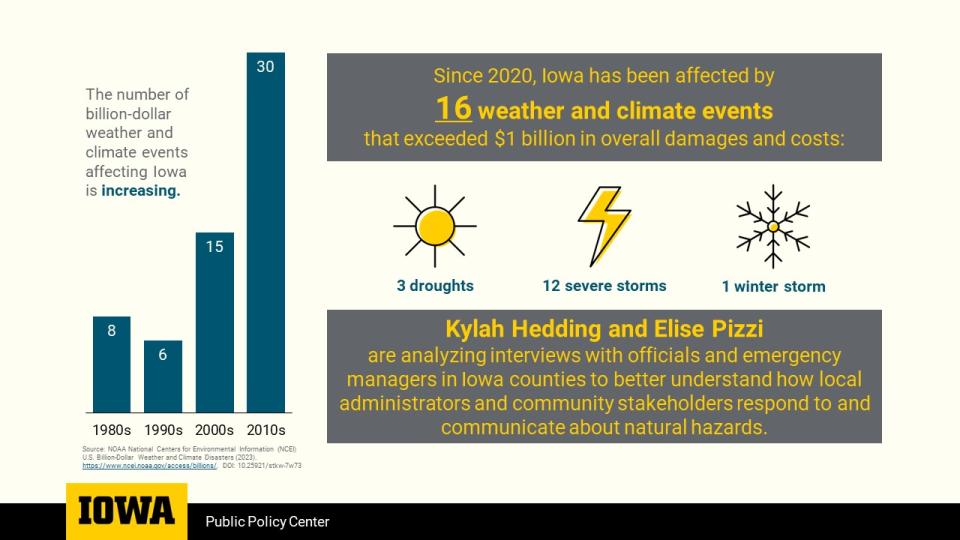
Summer Scholar Series - Elise Pizzi and Kylah Hedding
Thirty years ago, widespread flooding across Iowa caused extensive damage to homes, businesses, infrastructure, and agriculture. Since then, natural disasters have been increasing in both frequency and severity, according to data from the National Centers for Environmental Information. From 1990 to 1999, Iowa was affected by just six weather and climate events that exceeded $1 billion in overall damages and costs. In the following decade, fifteen billion-dollar disasters hit Iowa, including the 2008 flood that swept across the broader Iowa City area. The number of billion-dollar events doubled once again in the 2010s. Since 2020, Iowa has already been affected by sixteen natural hazards exceeding $1 billion in damages and costs. The role of local administrators in preparing for weather and climate crises such as droughts, severe storms, and winter storms cannot be understated.
To further understand the steps that county and local administrators take to ready themselves for natural hazards, Kylah Hedding, assistant professor in the School of Journalism and Mass Communication and Elise Pizzi, associate professor of Political Science, interviewed local leaders across eight counties in Iowa: Blackhawk, Buena Vista, Crawford, Fremont, Johnson, Linn, Mills, and Pottawattamie.
“We tried to pick counties that had as much variation as possible,” Pizzi says. “We looked at geographic, socioeconomic, and demographic factors. We also looked at counties who had recent experiences with a range of weather events, including, floods, tornadoes, and the 2020 derecho.”
With support from the PPC, Pizzi and Hedding hired a team of undergraduate students to conduct 26 interviews with emergency management coordinators and other local officials across the eight chosen counties. Using a thematic analysis approach, the team found two major themes that were common across the counties. First, they found that even with disaster plans in place, it’s difficult to plan for every eventuality. However, better planning allows emergency response to effectively adjust and adapt to the key needs of the moment, even when the unexpected happens. Second, while communication is important when dealing with severe weather events, many aspects can be overlooked in the planning process.
“When we’re looking at disaster preparation, I was really interested in the communications aspect of it,” Hedding says. “I was not only interested in how media approaches coverage of natural disasters but in how local officials and community stakeholders are communicating with each other and their communities before, during, and after major weather events.”
This summer, Hedding and Pizzi hope to submit their findings on disaster recovery and adaptive resilience to State Politics and Policy Quarterly as well as their article on crisis communication and public trust to Environmental Communication. They also hope to draft and submit a white paper on best practices for natural disaster preparation.
